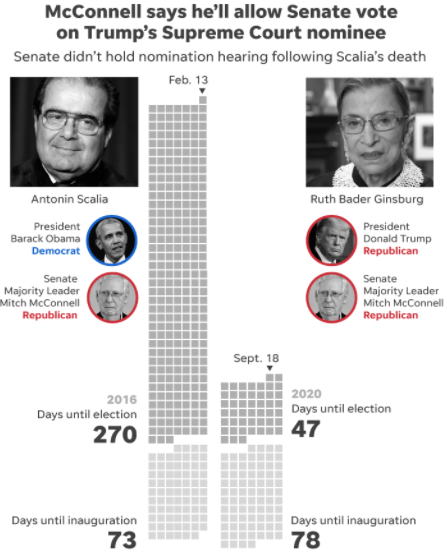The Political Battle Over RBG’s Replacement

Image courtesy of USA Today
October 8, 2020
Forty-six days before the Presidential election, Ruth Bader Ginsburg – a Supreme Court judge and pioneer for equality – passed away at the age of 87, and a heated dispute over her successor immediately ensued. In a final statement to her granddaughter and disclosed on NPR, Ginsburg expressed her desire to “not be replaced until a new president is installed”. President Trump has shown no indications of respecting her wish; he ensured supporters at a rally on September 18 that he plans to fill this vacancy with a “very talented, very brilliant woman”. The situation at hand greatly resembles that of 2016, during which the Republican Senate blocked Obama’s SCOTUS nominee months before the election, fueling the current Democratic argument that this process should be postponed until November 3.
In 2016, a vacancy on the Supreme Court arose following Justice Scalia’s death, yet the appointment for his replacement was postponed for 270 days. Senate leader Mitch McConnell and a Republican majority in the chamber refused to hold the nominee hearing for Merrick Garland, Obama’s appointee, on the grounds that the duty of filling the vacancy was that of the next president. Lindsey Graham, Current Chairman of the Senate Judiciary Committee, had stated in a Senate meeting that if “a vacancy occurs in the last year of the first [Presidential] term… let’s let the next President, whoever it might be, make that nomination”, and tempted reporters to use these words against him if he ever failed to uphold their moral value. Graham, and many other conservative Senators, openly declared that this 2016 Republican decision would set a precedent for what he called “the new rule” in similar scenarios.
The recent death of Justice Ginsburg has prompted some Republican Senators to say they believe the process should not move forward until after the election, in accordance with decisions made four years ago. Right-wing Senators like Lindsey Graham and Mitch McConnell are pushing for a nominee hearing before November 3, claiming that an election cannot be held with a vacant seat on the high court; McConnell, in a Senate session on September 21, described the 2016 ruling as such: “the American people [had] elected a [Republican] Senate majority” to regulate Obama’s actions, and justified the Republican change of heart as a response to “the American people’s [strengthening of] this Senate majority [in 2018] to keep confirming [Trump’s] impressive judicial nominees”. Our nation’s historical record features multiple Supreme Court vacancies filled in an election year and is overwhelmingly in favor of confirmation, yet it is unsure whether President Trump has the Republican caucus’ support on the matter. Trump, in a recent tweet, said that “the selection of United States Supreme Court Justices” is among the American government’s most important obligations; a week after Ginsburg’s death, information from Washington insiders rumor the identity of the nominee: judge Amy Coney Barret. This nomination will receive a vote on the Senate floor according to McConnell; now, the outcome is in the hands of the Senators. The nominee chosen to sit in Ginsburg’s former chair will participate in countless critical judgments throughout his/her lifelong career as a Supreme Court judge; undisputedly, the decisions made in the upcoming months regarding this issue will have an abiding impact on our country and its upcoming election, driving voters to the polls in favor of another Trump nominee or the first appointment in Biden’s Presidential term.









